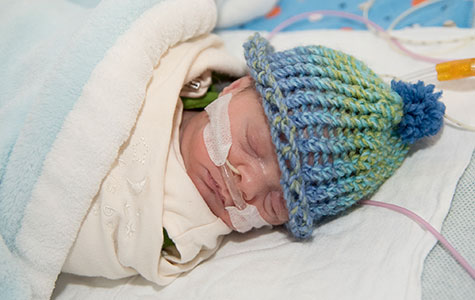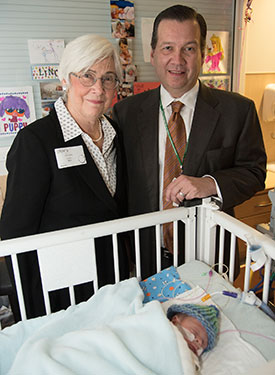
Washington University, St. Louis Children’s Hospital and the March of Dimes are launching the March of Dimes Prematurity Research Center at Washington University in St. Louis.
During the next five years, the March of Dimes will invest $10 million in the Prematurity Research Center. The research effort will feature a team-based, transdisciplinary approach to discovering the causes of preterm birth to develop new strategies to prevent it.
“This new prematurity research center continues our commitment to solving the problem of preterm birth,” said Jennifer Howse, PhD, president of the March of Dimes. “This center adds the expertise of Washington University’s leading scientists to a nationwide network of investigators whose discovery research will precisely determine what triggers early labor and how it can be prevented.”
Applications sought for research on preterm birth
The March of Dimes Prematurity Research Center at Washington University in St. Louis has announced a transdisciplinary developmental funding program for investigators with a faculty appointment of instructor or above to support early-stage, innovative research on preterm birth at the university.
The center was established to study multiple aspects of preterm birth, including: cervical remodeling during pregnancy, electrical maturation of uterine smooth muscle, and the role of circadian rhythms in preterm births. The center also will foster discoveries in other novel areas of preterm birth research through this program. Researchers in any discipline at the university are encouraged to explore high-risk ideas that will generate data for subsequent applications to the National Institutes of Health (NIH) or others.
Projects will be funded for one year at $25,000, with matching funds expected from the department chair sponsoring the researcher. A second year of support will be based on a progress report, with potential for $100,000 in total funding. Applications will be accepted until Jan. 30, 2015. Awards will be announced by Feb. 28, with funding to begin March 15. For more information, please contact Jessica Chubiz at chubizj@wudosis.wustl.edu.
In Missouri, 11.3 percent, or more than 8,000 babies, are born early each year. And the United States has one of the highest rates of preterm birth of any industrialized country.
Preterm birth is the leading cause of newborn death. Babies who survive have serious and sometimes lifelong health challenges, including breathing problems, jaundice, developmental delays, vision loss and cerebral palsy.
The first prematurity research center opened at Stanford University School of Medicine in 2011. The Ohio Collaborative, a partnership of the leading research centers in Cincinnati, Columbus and Cleveland, launched in 2013. Two others are planned, in addition to the new center at Washington University.
“As an obstetrician for 23 years, I have seen the impact of preterm birth on many families,” said George A. Macones, MD, the center’s program director and the Mitchell and Elaine Yanow Professor and chair of Obstetrics and Gynecology at Washington University. “We will not be able to prevent preterm birth until we can better understand the biological mechanisms that cause it. We are excited to partner with the March of Dimes on this Prematurity Research Center. With the science we will conduct, we hope to drastically reduce preterm birth in the U.S.”
The new center has three research themes:
Lihong V. Wang, PhD, and Methodius Tuuli, MD, will lead a team that will work to develop a new cervical-imaging device to help predict preterm birth. This device then will be tested in 1,000 women who receive prenatal care at Washington University Medical Center to compare cervical changes in women who deliver premature babies with such changes in women who deliver full-term babies. This will help researchers determine which early cervical changes require medical interventions to help prevent preterm births. Wang is the Gene K. Beare Distinguished Professor of Biomedical Engineering, and Tuuli is an assistant professor of obstetrics and gynecology and the medical director of labor and delivery at Washington University.

Alison G. Cahill, MD, and Phil Cuculich, MD, will lead a team with the goal of developing a new device that will image uterine contractions, similar to how the heart is imaged. These uterine images may help researchers understand why some women start having contractions at 26 weeks and other women don’t have contractions until their babies are full-term. This information might lead to new drugs and treatments that could stop a woman’s contractions in preterm birth. Cahill is an associate professor of obstetrics and gynecology and chief of the Division of Maternal-Fetal Medicine at Washington University, and Cuculich is an assistant professor of medicine and a member of the Cardiac Bioelectricity and Arrhythmia Center at Washington University.
Sarah England, PhD, Justin Fay, PhD, Erik Herzog, PhD, and Emily Jungheim, MD, will lead a team that will determine if disruptions of sleep patterns (related to circadian rhythms) are a risk factor in preterm birth. One day, this research might lead to preterm prevention strategies such as melatonin to regulate sleep or bright light therapy in high-risk women. England is a professor of obstetrics and gynecology, and Fay is an associate professor of genetics. Herzog is a professor of biology, and Jungheim is an assistant professor of obstetrics and gynecology and a Washington University Institute for Public Health Scholar.
England and Alan Schwartz, PhD, MD, the Harriet B. Spoehrer Professor, chair of the University’s Department of Pediatrics and pediatrician-in-chief at St. Louis Children’s Hospital, will serve as associate program directors of the center.
F. Sessions Cole, MD, chief medical officer at St. Louis Children’s Hospital and a March of Dimes National Trustee, said he hopes the research the new center supports will find better ways to prevent premature birth so the epidemic of preterm birth will end.
“Although we send ‘miracle babies’ home from St. Louis Children’s Hospital, many premature babies do not survive their early birth, and many others end up with lifelong health problems,” said Cole, also director of the Division of Newborn Medicine at Washington University and the Park J. White, MD, Professor of Pediatrics.